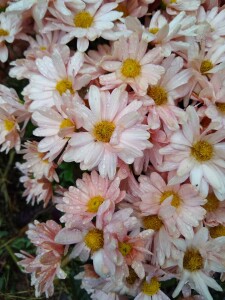 Chrysanthemums are not fragrant—at least not to my nose. In fact, an extract of chrysanthemum flowers, pyrethrin, is used as an insecticide, and insecticides almost never have a pleasant odor.
Chrysanthemums are not fragrant—at least not to my nose. In fact, an extract of chrysanthemum flowers, pyrethrin, is used as an insecticide, and insecticides almost never have a pleasant odor.
I generally prefer sweet smelling flowers, but I love chrysanthemums—a love that comes naturally. My mother was wild about them, especially the giant “football” mums and the slightly exotic spider mums. We always had pots of them around in the fall, inside and outside the house. I do the same now. Like my mother before me, I find that the plants are a balm to my thrifty soul, because they are both cheap and lovely. I also grow the perennial “garden” mums in my flowerbeds. They are among the last plants to go to sleep at the end of the growing season, and I cut stems for indoor arrangements through October and sometimes into November. Mums, whether homegrown or store bought, have the added advantage of outlasting most other cut flowers.
When you think about mums’ advantages, it makes the lack of alluring scent easier to bear.
I was intrigued recently by an article in one of the English gardening magazines about a woman in Cornwall who grows a vast array of mums. Sometimes she buys the plants from vendors, but she also propagates mums from cut stems that arrive in flower arrangements. When I read this, a light bulb clicked on in my brain. Florists’ mums sometimes come in shapes and colors that are not readily available to home gardeners. Propagating from stems is one way of adding some unusual varieties to the garden with little effort and even less expense. I decided to try it.
Right now a bouquet of mums from the supermarket is sitting in an old Pyrex measuring cup on my kitchen counter waiting to play a starring role in the middle of the Thanksgiving table. The blooms are various autumnal shades of russet, gold and dark red, with flowers in a mix of sizes and configurations. In keeping with the norm for supermarket flowers, the only information on the label is the price of the bouquet—no varietal names.
I figure there will almost certainly be some stems that are too short for the arrangement. I’ll set them aside, remove the leaves, and root them in small pots. They will most likely need bright indirect light, so I will find a space for them in my kitchen, dining room or home office, where I can keep an eye on them. The magazine article doesn’t say anything about rooting hormone, and I don’t happen to have any on hand, so I’ll do without. If I think of it, I’ll make some willow water from the branches of the little willow in the front yard and water the cuttings with it. I have found though, that plants with natural rooting propensity, like tradescantia, coleus and orchid cactus, don’t need any help at all. I have been absentminded and more than a bit disorganized since birth, so the rooting trait is a boon to my gardening efforts.
My fall garden tends to lack interest once the aster tsunami has passed. A few carefully cultivated chrysanthemum plants with interesting flower shapes and colors might close out the season on a higher and more floriferous note. Next fall, it will be quite satisfying to see my cutting-grown chrysanthemums come full circle when I cut stems for indoor arrangements.
In my day-to-day life, I have become more and more wedded to the idea of adapting and reusing what I already have on hand. I gather greens from the garden to fill out bouquets and decorate for the holidays. Before I buy new decorative items, I check all the storage boxes for old ones that are waiting for new opportunities to shine. Propagating a few chrysanthemum cuttings is another easy way of pursuing sustainability.
In this season of rampant consumerism, it is my own small way of getting back to basics.
